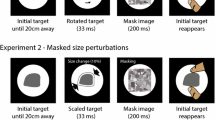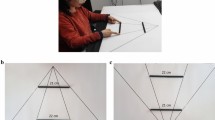Abstract
While the neural bases of prehension have been extensively studied in monkeys, a few kinematic studies have examined their prehension behavior. Recently (Roy et al. 2000, 2002), we have described the kinematics of reaching and grasping in freely behaving monkeys under normal conditions by applying the high-resolution recording techniques (Optotrak® system) and behavioral paradigms used in humans. Here we determined whether online movement reorganization observed in monkeys following sudden changes of either object size or location at movement onset is similar to that observed in humans. We found that changing object size led to rapid on-flight re-calibration of the different movement parameters, eventually preserving the unitary aspect of the movement with a minor time cost. By contrast, a shift in object location triggered a massive time-consuming reorganization. Re-directed movements appeared as a concatenation of two sub-movements: a first one directed to the initial object and a second one directed to the new object location. These findings first complement our earlier studies in providing further evidence of the similarities between monkey and human prehension. Second, they suggest that the two components of prehension, reaching and grasping, interact through coordination mechanisms that are more efficient to correct for size than for location perturbation. This difference may reflect a hierarchical organization in which reaching would be the subordinate of grasping in both primate species.




Similar content being viewed by others
References
Battaglini PP, Muzur A, Galletti C, Skrap M, Brovelli A, Fattori P (2002) Effects of lesions to area V6A in monkeys. Exp Brain Res 144:419–422
Carey D, Otto de Haart EG (2001) Hemispatial differences in visually guided aiming are neither hemispatial nor visual. Neuropsychologia 39:885–894
Carnahan H, Goodale MA, Marteniuk RG (1993) Grasping versus pointing and the differential use of visual feedback. Hum Mov Sci 12:219–234
Castiello U, Bennett KMB, Paulignan Y (1992) Does the type of prehension influence the kinematics of reaching. Behav Brain Res 50:7–15
Castiello U, Bennett KMB, Stelmach GE (1993) Reach to grasp: the natural response to perturbation of object size. Exp Brain Res 94:163–178
Dubrowski A, Bock O, Carnahan H, Jungling S (2002) The coordination of hand transport and grasp formation during single- and double-perturbed human prehension movements. Exp Brain Res 145:365–371
Fattori P, Breveglieri R, Amoroso K, Galletti C (2004) Evidence for both reaching and grasping activity in the medial parieto-occipital cortex of the macaque. Eur J Neurosci 20:2457–2466
Galletti C, Gamberini M, Kutz DF, Fattori P, Luppino G, Matelli M (2001) The cortical connections of area V6: an occipito-parietal network processing visual information. Eur J Neurosci 13:1572–1588
Galletti C, Kutz DF, Gamberini M, Breveglieri R, Fattori P (2003) Role of the medial parieto-occipital cortex in the control of reaching and grasping movements. Exp Brain Res 153:158–170
Gentilucci M, Chieffi S, Scarpa M, Castiello U (1992) Temporal coupling between transport and grasp components during prehension movements: effects of visual perturbation. Behav Brain Res 47:71–82
Gordon J, Gilhardi MF, Cooper SE, Ghez C (1994) Accuracy of planar reaching movements. II. Systematic errors resulting from inertial anisotropy. Exp Brain Res 99:112–130
Haggard P, Wing AM (1991) Remote responses to perturbation in human prehension. Neurosci Lett 122: 103–108
Haggard P, Wing AM (1995) Coordinated responses following mechanical perturbation of the arm during prehension. Exp Brain Res 102:483–494
Jeannerod M (1981) Intersegmental coordination during reaching at natural visual objects. In: Long J, Baddeley A (eds) Attention and performance IX. Lawrence Erlbaum Associates Publishers, Hillsdale NJ, pp 153–168
Jeannerod M, Biguer B (1982) Visuomotor mechanisms in reaching within extrapersonal space. In: Ingle D, Goodale MA, Mansfield R (eds) Advances in the analysis of visual behavior, MIT Press, Boston, pp 387–409
Mason CR, Theverapperuma LS, Hendrix CM, Ebner TJ (2004) Monkey hand postural synergies during reach-to-grasp in the absence of vision of the hand and object. J Neurophysiol 91:2826–2837
Matelli M, Govoni P, Galletti C, Kutz DF, Luppino G (1998) Superior area 6 afferents from the superior parietal lobule in themacaque monkey. J Comp Neurol 402:327–352
Paulignan Y, MacKenzie CL, Marteniuk RG, Jeannerod M (1991a) Selective perturbation of visual input during prehension movements. 1. The effects of changing object position. Exp Brain Res 83:502–512
Paulignan Y, Jeannerod M, MacKenzie CL, Marteniuk RG (1991b) Selective perturbation of visual input during prehension movements. 2. effects of changing object size. Exp Brain Res 87:407–420
Roy AC, Paulignan Y, Farné A, Jouffrais C, Boussaoud D (2000) Hand kinematics during reaching and grasping in the macaque monkey. Behav Brain Res 117:75–82
Roy AC, Paulignan Y, Meunier M, Boussaoud D (2002) Prehension movements in the macaque monkey: effects of object size and location. J Neurophysiol 88:1491–1499
Shipp S, Blanton M, Zeki SA (1998) Visuo-somatomotor pathway through superior parietal cortex in the macaque monkey: cortical connections of areas V6 and V6A. Eur J Neurosci 10:3171–3193
Tanné J, Boussaoud D, Boyer-Zeller N, Rouiller EM (1995) Direct visual pathways for reaching movements in the macaque monkey. Neuroreport 7:267–272
Tanné-Gariepy J, Rouiller EM, Boussaoud D (2002) Parietal inputs to dorsal versus ventral premotor areas in the macaque monkey: evidence for largely segregated visuomotor pathways. Exp Brain Res 145:91–103
Acknowledgement
We thank A. Farné for helpful comments on the manuscript; M. Thevenet, B. Messaoudi, B. Bertrand and C. Etienne for technical assistance; and JL Charieau for animal care. This work was supported by CNRS and Université Claude Bernard Lyon 1. ACR was supported by the Ministère de l’Education Nationale (France) and by the Bettencourt-Shueller foundation (Paris).
Author information
Authors and Affiliations
Corresponding author
Rights and permissions
About this article
Cite this article
Roy, A.C., Paulignan, Y., Meunier, M. et al. Prehension movements in the macaque monkey: effects of perturbation of object size and location. Exp Brain Res 169, 182–193 (2006). https://doi.org/10.1007/s00221-005-0133-8
Received:
Accepted:
Published:
Issue Date:
DOI: https://doi.org/10.1007/s00221-005-0133-8




